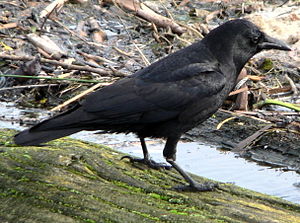Field Guide/Birds/Corvus brachyrhynchos
| Corvus brachyrhynchos (American Crow) | |
|---|---|
 |
 |
| Description | |
| The American Crowis a common bird found throughout North America. Entirely black, it is an easily recognized bird.
The American Crow is a distinctive bird with iridescent black feathers. Its legs, feet and bill are also black. Several regional forms are recognized and differ in bill proportion and overall size from each other across North America, generally being smallest in the southeast and the far west. Averaging 18 inches (46 cm) in length, it is smaller than the Common Raven. American Crows have a lifespan of 7 to 8 years. Captive birds are known to have lived up to 30 years. The most usual call is a loud, short, and rapid "caah-caah-caah". Usually, the birds thrust their heads up and down as they utter this call. American Crows can also produce a wide variety of sounds and sometimes mimic noises made by other animals, including other birds. Crows live in virtually all types of country from wilderness, farmland, parks, open woodland to towns and major cities. The crow is generally a permanent resident, but many birds in the northern parts of the range migrate short distances southward. Outside of the nesting season, these birds often gather in large communal roosts at night. American Crows are protected by the Migratory Bird Treaty Act of 1918. The American Crow is omnivorous. It will feed on invertebrates of all types, carrion, scraps of human food, seeds, eggs and nestlings, stranded fish on the shore and various grains. American Crows are active hunters and will prey on mice, frogs, and other small animals. In winter and autumn, the diet of American Crows is more dependent on nuts and acorns. Occasionally, they will visit bird feeders. Like most crows, they will scavenge at rubbish dumps, scattering garbage in the process. Where available, corn, wheat and other agricultural crops are a favorite food. These habits have historically caused the American Crow to be considered a nuisance. However, it is suspected that the harm to crops is offset by the service the American Crow provides by eating insect pests. American Crows are monogamous cooperative breeding birds. Mated pairs form large families of up to 15 individuals from several breeding seasons that remain together for many years. Offspring from a previous nesting season will usually remain with the family to assist in rearing new nestlings. American Crows do not reach breeding age for at least two years. Most do not leave the nest to breed for four to five years. American Crows build bulky stick nests, nearly always in trees but sometimes also in large bushes and, very rarely, on the ground. They will nest in a wide variety of trees, including large conifers, although oaks are most often used. Three to six eggs are laid and incubated for 18 days. The young are fledged usually by about 35 days. Despite attempts by humans in some areas to drive away or eliminate these birds, they remain widespread and very common. The number of individual American Crows is estimated by Birdlife International to be around 31,000,000. The large population, as well as its vast range, are the reasons why the American Crow is considered to be of least concern, meaning that the species is not at immediate risk. | |